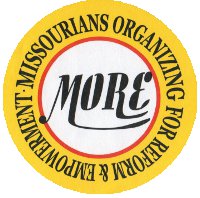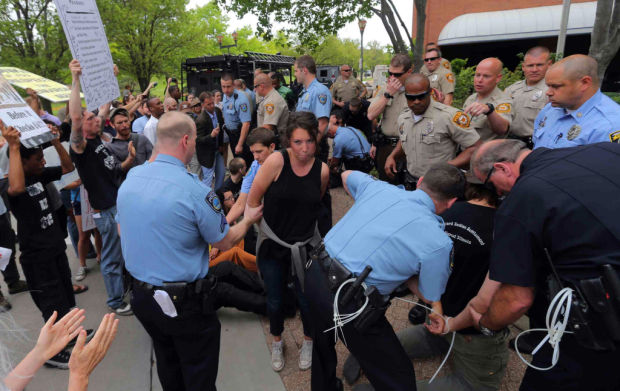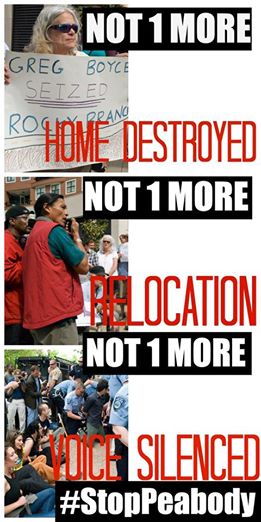
Radical Organizing 101: Training with MORE in St. Louis
For the past three weeks, I’ve been in St. Louis in a three-week immersive organizing training with the organization MORE (Missourians Organizing for Reform and Empowerment). I’ve grown and changed as a person so much in these three weeks, and as can be imagined, I’m bringing back with me far more than I could fit in a blog post. So because this post will be long, I’ve divided into sections so you can skim and read the parts that most interest you.
1. Theory Behind the Training
2. Group Cohesion: Learning and Relationships
3. Reflections on Direct Action
Theory Behind the Training
This training was designed to be the first of many–a test run to develop a model that could be replicated and spread throughout the country. The larger questions in a training program like this are: “How do we create more, and massive, radical left-oriented groups?” and “How do we train them to have the skills they need to make transformative change?” How do we create truly community-led and bought-in groups that cause disruption (nonviolent direct action), at scale?
So what are the skills that activists need to create transformative change? The training was broken down into three rough categories:
- Community Organizing (how to meet, agitate and organize a large number of people to take positive change into their own hands)
- Nonviolent Direct Action (creating disruptions in business as usual for decision-makers that force them to act)
- Raising money to sustain yourself
The training was structured in the following way: the sit-down, skill-share or discussion-based learning happened in the mornings, and in the afternoons the 6 trainees broke into pairs to apply lessons directly by working on one of MORE’s three campaigns. The “embedding” nature of the training was incredibly useful: having a mentor of the MORE organizer running the campaign, and yet being given full responsibility for the tasks given–petitioning, talking to people about the campaign, setting up and having 1-on-1s, asking for dues, turnout for meetings. I learned ten times as much in the experience of actually working on a campaign than I could have from listening or even role plays.
If there’s one thing I internalized from this training, it’s the beauty and the magic of actually organizing: actually going out and talking to people who live in a community, hearing what their concerns are, seeing their passion and their desire to make change. Getting people from a community involved in the fight: that is organizing, that is the work. I think something built into the work we’ve done as the Maypop Collective is an awe, or maybe even fear, of community organizing. We can be perfectionists, and worry about controlling the message and process of our work to a “T”, and we’ve seen campaigns as big, huge commitments, requiring the capacity of many (if not all) members of Maypop. We conceive of campaigns as requiring time commitments of years in order to not run out on a community after starting something.
And that care for the community is important! But MORE has a different model of organizing. Pick a campaign you think might work; go out and talk to people; if it’s a problem, they’ll respond–they will be pissed and ready to come out and get involved. MORE has built an organization that truly works on issues that resonate with low-income people and people of color, that are affecting their daily lives. And that means people show up, they care, they get it, and they’re ripe for getting involved, getting trained, and becoming leaders themselves. Reginald Rounds, a MORE member who participated in the training, is a perfect example of that. He’s a native of St. Louis, and has been personally affected by the lack of jobs after getting a degree from a green jobs program out of St. Louis University. He got involved with MORE, started dropping by the office to do odd tasks, then got hundreds of signatures for MORE’s Take Back St. Louis ballot initiative. And he continues to develop as an organizer and take on increasing responsibility in the organization.
There’s really something to be said for having an organization that is built for intake. MORE’s theory of change is simple: we need to get the people who are most affected together to disrupt business as usual for people in power–that’s what ultimately wins. So MORE is built around 1) Finding out what campaigns matter to people in St. Louis (from the perspective of what will cause real change in systems of environmental and economic injustice), 2) Outreaching to as many people as possible to get them involved and engaged, 3) Putting pressure on power in whatever ways possible from meetings, phone calls, to direct action and civil disobedience.
MORE isn’t afraid to take on too much, or feel constrained to have a 5-year plan for every campaign they start. They don’t feel the need to be perfect or to micromanage every detail and message of the campaigns, because they’re as much decided by the people who show up to move the campaign, as by the organizers. If there was a plan for an action but too many pressing things come up and it has to be cancelled, oh well. If an opportunity comes up and people are excited to get arrested next week–go for it! The rooting in members of community and ease of intake of volunteers both make MORE’s campaigns truly matter, truly big and powerful, and allow organizers to step away from the role of God and trust in the people they work for.
Good Community Organizing = antidote for:
-
Smallness and powerlessness
-
Perfectionism
-
Irrelevance
Group Cohesion: Learning and Relationships
Monday, May 5:
Waking up and coming down to the kitchen at 7am, I see various pieces of our varied existence scattered around the room. Jon’s fanny pack is sitting on the table, my shoes wait quietly by the door, Casey’s wallet lays out. I feel like a proud mother surveying the house in a calm before the family wakes up. St. Louis has turned into some kind of home for me.
In the first week of the training, I thought I was going home early. I couldn’t feel the importance of any of the skills we were learning, I didn’t understand who the other members of the cohort were, what they had done, how I could learn anything from them, the silences when we were together felt oppressive and empty. What really changed that dynamic was the first weekend–one night we went to the City Museum together (if you don’t know it: a huge 3-story adult playground), followed by a dance club, and walking home because Dan’s car got towed. The details of this story could be interchangeable: the lesson is that we had to be put in a situation where we could be vulnerable, open, lose our shyness and inhibition, and get a glimpse of who we all really are. After that experience and a sense of shared identity set in, my relationship to the actual content and training itself completely changed.
It’s hard to quantify why this group of 5 (6? 7? And the edges of the “cohort” blur a little, which also feels good) feels so close, has cohered into a strong fabric. I don’t think it has to do with the training or content of what we’ve done–it’s the spaces between, the un-scripted parts, that weave the “work” together. Living together, having shared responsibilities like cooking and cleaning, driving squashed up 6 people to a car every day, taking opportunities to have fun together. Staying up all night to finish a banner.
I also believe I was blessed with the group of people I was with. The three weeks made me take a good hard look at the first impressions I make of people–to see 5 people who present as white male anarchists and immediately jump to conclusions about their mode of operating, sensitivity, ability to listen, or to care–that’s something I’m not proud to admit to. (I’m also not proud to admit that I made assumptions about people’s identities that aren’t true–although male-presenting, there were people in this cohort who identify as gay and as “genderqueer,” not conforming to male or female). If I hadn’t stayed for the full length of the training, I would not have learned how deeply cared for I could be by this group and by individuals in it, how deeply mindful and critical of lack of anti-oppressive practices and operation within this training, how much I could learn about tactics I had unconsciously dismissed as flashy and un-strategic.
The “outcomes” or “next steps” from this training aren’t known–we’re making this up as we go along. I’ve toyed in my head with the idea of setting up “buddies” or partners that continue to check on each other and our campaigns–someone to talk to about how we’re applying this training to our work, setting goals for ourselves, asking questions and sharing frustrations or blocks. I know I’ll see these people again, but maybe not ever together in the same place. I want to continue the relationships I’ve built while here–and that’s largely because I not only care about the collection of skills, vision and strategy tied up in each person’s head, but I care for each person’s being and I want to continue caring, and being cared for in return.
Reflections on Direct Action
Thursday, May 8th:
Where can words even begin to express the feeling of being part of an action? You spend days doing outreach, nights planning message and scenarios and brainstorming creative tactic ideas, hours painting banners and signs, and just minutes on the day, chanting a few chants, waiting, pushing, getting arrested–and it’s over. (Which really means, the work begins! Jail support, social and print media push, picking up and caring for arrestees, and action debriefing are still to come.)
Today, a group of local St. Louis residents joined with members of communities from across the country who are all affected by Peabody’s crushing footprint, to disrupt Peabody’s annual shareholder meeting. Check out the article in St. Louis Today. While 8 people with shares attempted to enter the meeting, we rallied outside the hotel–and when our shareholders weren’t allowed in the meeting, we joined them to push through the police lines and deliver a message to Peabody ourselves.
I’d never been in the center of planning a large action before–I’ve been a participant in many of the Earth Quaker Action Team’s actions where the tactic, scenarios, and action leading had already been decided upon and delegated by the time I was on board, I was a chant leader for an action during Mountain Justice Spring Break in Charleston, WV, and I was a key planner for a few actions with Swarthmore Mountain Justice, notably the takeover of the Board of Managers meeting on campus last May. In some ways the action today was most similar to my experience with that disruption: using expertise in non-violent direct action to open up space for the voices of other groups in a coalition, looking to them for leadership on messaging and the extent of the escalation.
The main goal of MORE for this action was to shut down the Peabody shareholder meeting (the hashtag used for this action was straight-up #StopPeabody). There’s no negotiation and no real demand that doesn’t necessitate ending the company once and for all. However, before deciding what tactics to use or putting in motion the more elaborate plans to shut down the meeting, it was important to talk to the people from affected communities who were coming in to take part in the meeting. Two members of Black Mesa Water Coalition flew in from Arizona (the site of an ongoing genocide and relocation by Peabody of native Dineh people from ancestral lands), and four incredible women from Rocky Branch came from southern Illinois (where Peabody has corrupted the local democratic process to literally take over public access roads in a rural community). So it was of utmost importance to ask from them whether they wanted the chance to have questions answered by the CEO of Peabody, or whether they were in favor of shutting down the meeting.
During the action planning process (which consisted of three, hours-long meetings in the three days leading up to the action), I found it excruciating. I remember asking Casey afterwards “Are all action planning processes like this? Aren’t there tools and facilitation tricks to make things go faster or smoother or more linearly?” That’s me–I always want a structure to save us. And perhaps the earlier meetings, before frontline folks arrived, could have been streamlined with clearer parameters, or a more structured discussion moving from narrative, to action brainstorm, to feasibility discussion, to scenarios.
But once we had everyone in a room, things started happening that would definitely not have been on my facilitation plan. The people from lands affected by Peabody went around and told their stories–where they are right now, how the history of the region affects their current struggles, their lives, and their families. Conversation meandered back and forth–were we talking about the narrative of the action, or were we talking about what we must do going forward, or were we throwing out ideas for what the action could be? It would have driven me crazy to be facilitating that room.
And thank God I wasn’t, because I completely missed much of what was really happening in that room. The people around the table, a seemingly strange assortment of older white women from the rural Midwest, traditional Dineh farmers and sheepherders, young white anarchists, trained community organizers, and local black St. Louis residents, had never met one another before this day. We were planning an action for only 10% of the time–the rest was weaving together a group for ourselves, a place in coalition and coexistence where we could understand a shared language of grievance, passion, of respect, sorrow, empathy and even remorse. A shared understanding of being connected in a way that lasts long after this action. The action was the spark for the meeting, the wagon that everyone could be hitched to so they were going in the same direction. But the conversations had in this meeting, the emotions expressed and deep sense of gratitude, are the deeply rooted work of building a long-term movement. The depth of emotion I saw, especially between Rocky Branch women and the Dineh, was staggering. During the conversation, one of the women apologized to the Dineh for the horror imposed on them by her ancestors: “We are just now starting to feel what your people have felt for over 500 years.”
There was a moment in the action that I hope I will never forget. The first line of people locked arms and pushed forward to the police line, and the wave of the rally flowed behind them to take the street and support them. “The people united will never be defeated!” was ringing out, louder than I’ve ever heard. Then I felt a kind of wildness, a rushing of blood, like electricity flowing in my veins. I looked back to see Marshall, one of the Dineh resisters, singing a chant in Dineh into the megaphone. The raw power, the spirit seemed to fill the entire world up to the sky, and everyone around me moved and clapped and cried out with that same pulsing energy, “The People, United, Will Never Be Defeated!” In that moment we seemed to grasp the ten-fold synergy of being together in this movement.






